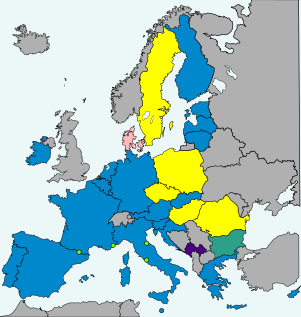
Back Δανία και ευρώ Greek Tanskan liittyminen euroalueeseen Finnish Euro et Danemark French Adozione dell'euro in Danimarca Italian Denemarken en de euro Dutch Данія та євро Ukrainian

- European Union member states (special territories not shown)
- 20 in the eurozone1 in ERM II, with an opt-out (Denmark)5 not in ERM II, but obliged to join the eurozone on meeting the convergence criteria (Czech Republic, Hungary, Poland, Romania, and Sweden)
- Non–EU member states
Denmark uses the krone as its currency and does not use the euro, having negotiated the right to opt out from participation under the Maastricht Treaty of 1992. In 2000, the government held a referendum on introducing the euro, which was defeated with 53.2% voting no and 46.8% voting yes. The Danish krone is part of the ERM II mechanism, so its exchange rate is tied to within 2.25% of the euro.
Many political parties in Denmark favour the introduction of the euro and the idea of a second referendum has even been suggested several times since 2000. However, some important parties such as the Danish People's Party, Socialist People's Party and Red–Green Alliance do not support joining the currency. Public opinion surveys have shown fluctuating support for the single currency with majorities in favour for some years after the physical introduction of the currency. However, following the financial crisis of 2008, support began to fall, and in late 2011, support for the euro crashed in light of the escalating European sovereign debt crisis.[1]
Denmark borders one eurozone member, Germany, and one EU member that is obliged to adopt the euro in the future but currently has no plans to do so, Sweden.
International finance scholars generally consider currency pegs to be fragile, yet Denmark has been able to maintain the krone peg to the euro consistently since the euro's introduction in 1999.[2][3]
- ^ "Danskerne siger nej tak til euroen". Business.dk (in Danish). 27 September 2011. Retrieved 29 September 2011.
- ^ Eichengreen, Barry (2023). "The Danish problem". Economia Politica. 40 (3): 781–794. doi:10.1007/s40888-023-00313-y. ISSN 1973-820X.
- ^ Molnár Vojtěch (13 March 2024). "cnBlog – Denmark's monetary policy: Permanently halfway to the euro?". Czech National Bank. Archived from the original on 15 March 2024. Retrieved 15 March 2024.